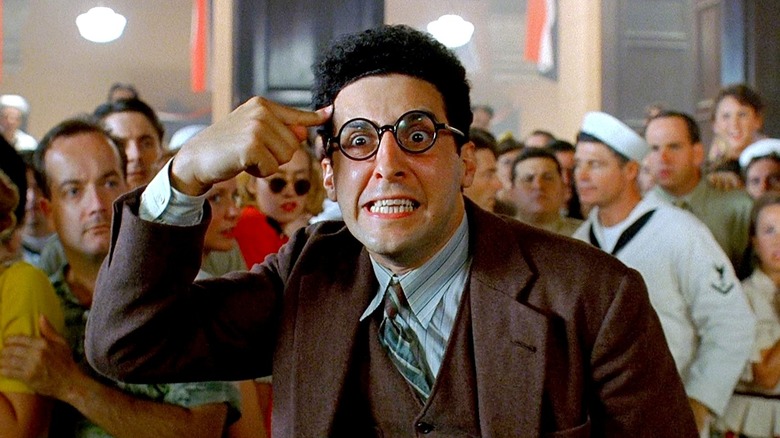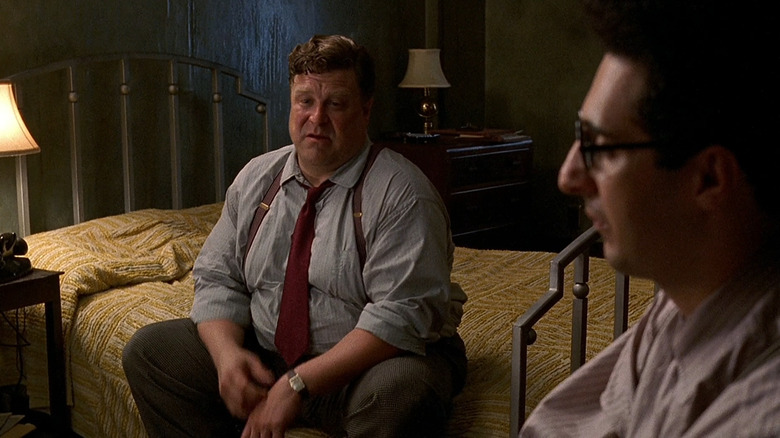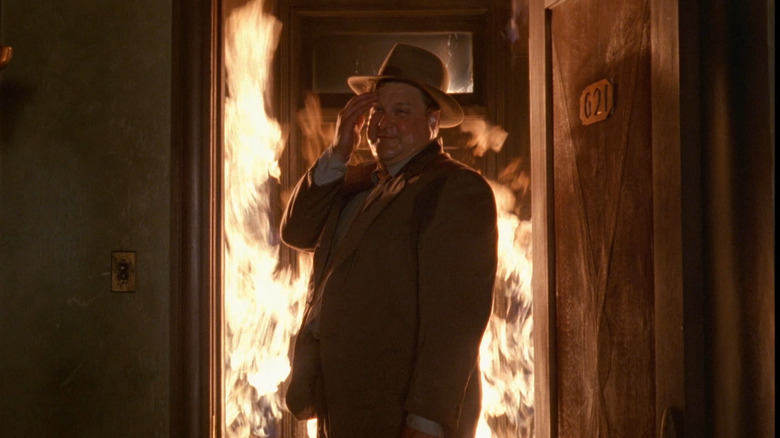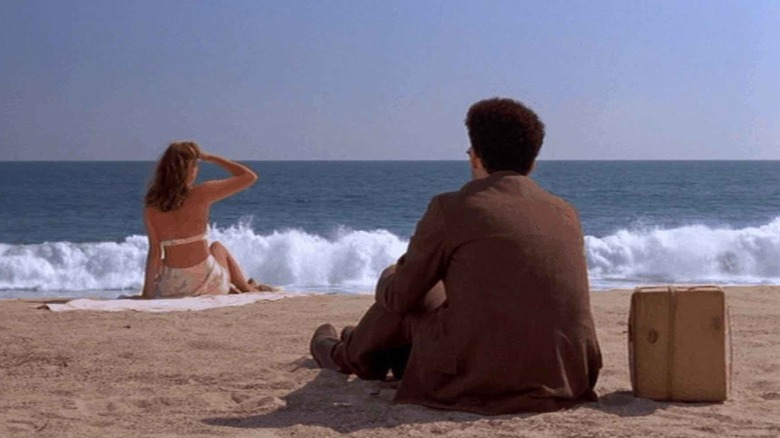Barton Fink Ending Explained: Showing You The Life Of The Mind
A few years before a fiendish serial killer sent Brad Pitt the worst surprise gift ever, there was another suspiciously head-sized box in the Coen Brothers' "Barton Fink." We never find out exactly what is in it, but we can have a pretty good guess — which is more than can be said for the film's other unresolved ending.
"Barton Fink" sometimes gets a little lost in the conversation about the Coen's films, although it comfortably ranks among their best. Maybe that's no surprise; even by their idiosyncratic standards, the film is a bit of a standalone, perhaps closer to the equally mysterious "A Serious Man" than anything else in their filmography. It's a dialogue-heavy, pitch-black psychological comedy drenched in a stifling atmosphere, focusing on a resolutely unlikeable protagonist. "Barton Fink" feels deliberately obtuse, which may be why it exasperates just as many people as it delights – it's an accumulation of odd details and clues that are designed to baffle and frustrate rather than pay-off in any regular sense.
The film was a box office bomb, but swept three major awards at Cannes – the Palme d'Or, Best Director, and Best Actor for John Turturro. It's the kind of puzzle box of a movie that film buffs love poring over and debating, so let's go ahead and unpack that ending.
What is Barton Fink About?
The movie takes place in 1941. Turturro plays Barton Fink, a pretentious yet rather naive New York playwright who has just received accolades for his Broadway play. He's invited out to Hollywood by Jack Lipnick (Michael Lerner), the monstrous mogul of Capitol Pictures, who puts him on contract and sets him to writing a Wallace Beery wrestling movie.
Checking into a threadbare room in a faded old hotel, Fink settles down to work. He's instantly struck down with writer's block, struggling with something he considers low art and distracted by noises coming from the room next door.
When Fink complains to reception about the disturbances, his neighbor comes to apologize. Enter Charlie Meadows (John Goodman), a folksy traveling insurance salesman. He's the epitome of the "common man" that Fink claims to care about so much, although he barely lets the guy get a word in edgewise.
The two form a peculiar friendship as Fink continues his struggles with the screenplay. Frustrated, he approaches alcoholic writer W.P. Mayhew (John Mahoney) for advice. He's not much use, but Fink discovers that his long-suffering secretary Audrey (Judy Davis) ghost-wrote most of his screenplays anyway.
With his deadline looming, Fink asks Audrey for help and they end up falling into the sack together. The next morning, he awakes to discover she has been murdered while he slept. Fink panics and asks Charlie for help instead of calling the cops. Charlie removes the body and heads off to New York, leaving the suspicious package in Fink's care. Finally, he is able to finish the screenplay, but he is soon visited by two detectives, who tell him Charlie's real name is Karl "Madman" Muntz...
The Coens Were In A Weird Place
Stuck while writing their dense, labyrinthine film noir "Miller's Crossing," the Coens decided to take a little break and focus on something else. You or I might take a vacation, or focus on something a bit frothier and throwaway to give the brain cells a breather, but not the these guys. They headed to New York instead and bashed out the screenplay for "Barton Fink" in just three weeks instead.
The Coens famously don't like to admit that they were blocked on "Miller's Crossing", but there certainly seems to be a meta quality to the endeavor, with a clear parallel between their predicament and Fink's situation. The end result gets under the skin of a blocked writer perhaps better than any other film.
"Barton Fink" wasn't just a limbering-up exercise before the final push on the Coens' "Miller's Crossing" screenplay. They wanted to write a strong role for their friend Turturro, who went on to star in five of their pictures, most famously as the pederast bowler Jesus Quintana in "The Big Lebowski." They were also intrigued by the idea of setting a movie in a crumbling hotel, inspired by a place they had seen while filming "Blood Simple" in Austin, Texas.
Setting "Barton Fink" in 1941 was also significant. As America entered the war, the Coens imagined a hotel populated by the weirdos, cranks, and old folk who had been left behind while others went off to fight. The time and place gave them a rich Hollywood background to tap into, with the Mayhew character based on William Faulkner, and Lipnick playing an amalgam of larger-than-life producers like Louis B. Mayer and Harry Cohn.
What Happens At The End Of Barton Fink
"Barton Fink" concludes with two unresolved mysteries. The first seems fairly straightforward (it's pretty heavily indicated that the box contains Audrey's severed head). The detectives tell Fink that Muntz likes to decapitate his victims, and Charlie constantly makes "head" references throughout their conversations.
The second mystery is harder to fathom. Earlier in the film, the sole bright spot in Fink's drab hotel room is a corny old picture of a woman sitting on a beach. She sits with her back to the camera, apparently gazing out to sea. As Fink stares at the image, he hears the ocean in his mind.
At the end, after Charlie's hellish return to the hotel and Lipnick blowing Fink's screenplay out of the water, he wanders along a beach with the box. He has a brief, awkward conversation with a young woman, who settles into a pose identical to that of the hotel picture.
That final exchange has a pun-like quality — "are you in pictures?" — and any meaning is undoubtedly ironic. Fink has spent the whole movie painfully trying to breathe life into something he considers beneath him, eventually turning it into his idea of art, only to have it comprehensively trashed by Lipnick. Now, in the final scene, he sees another example of "low art" come magically, effortlessly to life before his very eyes. As Joel Coen stated in an interview about the film, they were "aiming for a logic of the irrational."
In creating one of the most enigmatic endings of the past 30 years, there is little doubt that they succeeded.



